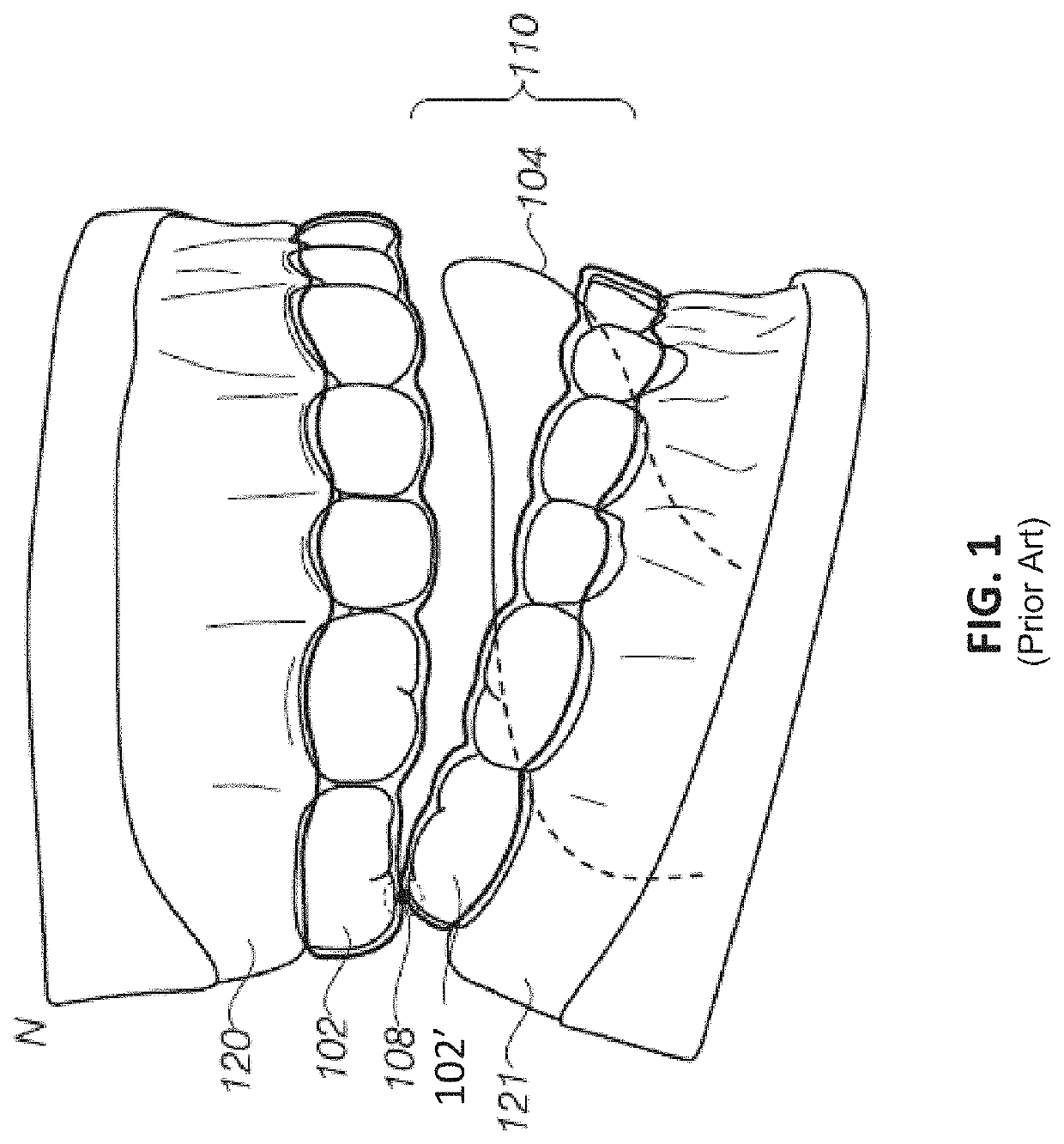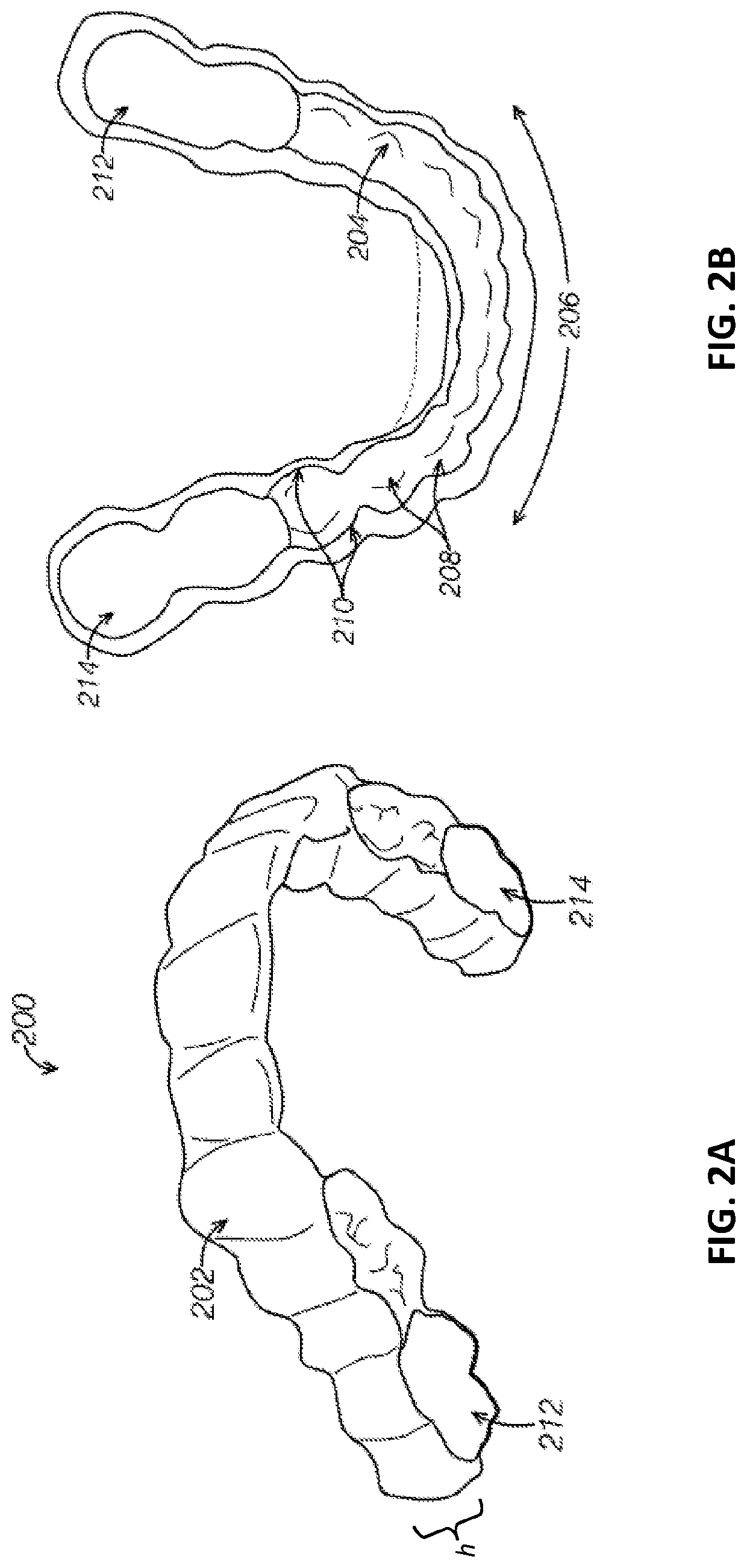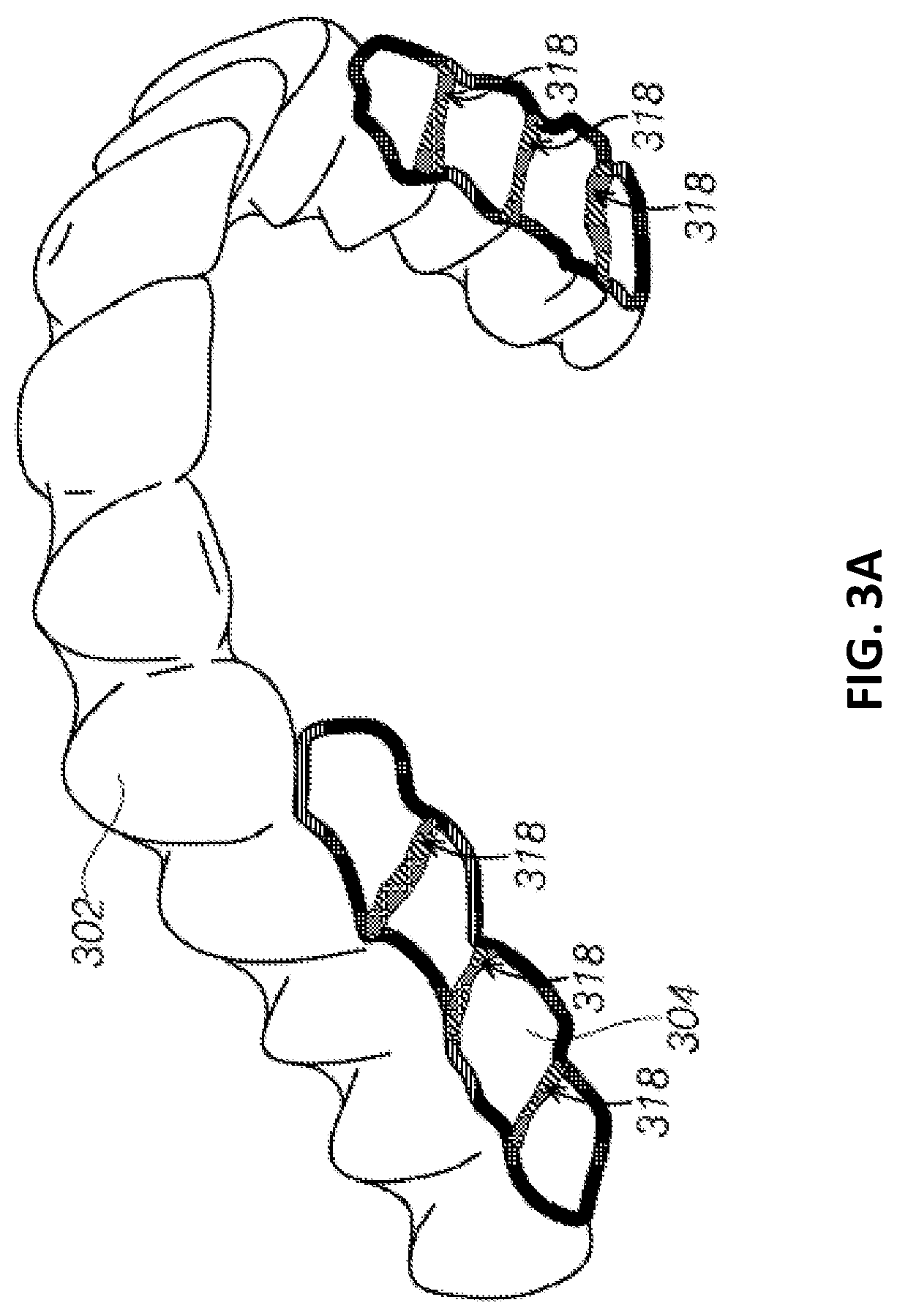[0006]The present application relates to an orthodontic device that may prevent, reduce, or inhibit poor speech articulation due to the inability to form an adequate seal between the tongue and the inner surfaces of a patient's teeth, which may result in lisping.
[0007]The devices may generally include an occlusal portion having a dentition-receiving cavity extending laterally in an arch and having a first vertical height, wherein the dentition-receiving cavity is configured to fit over a dental arch of a patient, the dentition-receiving cavity comprising an occlusal surface section adapted to be positioned over an occlusal surface of the patient's teeth. The device comprises a barrier portion extending laterally and adjacent to a region of the occlusal portion (e.g., a front region, a lateral region, etc.), the barrier portion having a second vertical height that is approximately the same height or a greater height than the first vertical height, wherein the barrier portion is laterally continuous to reduce or prevent air leakage therethrough, so that a patient's tongue may form a seal against the barrier portion when the patient is speaking while wearing the device.
[0008]In another aspect, the application relates to an orthodontic aligner device that prevents lisping. The device comprises an occlusal portion having a dentition-receiving cavity extending laterally in an arch and having a first vertical height, wherein the dentition-receiving cavity is configured to fit over a dental arch of a patient, the occlusal portion further configured to apply a force to a first set of teeth in the dentition-receiving cavity, the dentition-receiving cavity comprising an occlusal surface section adapted to be positioned over an occlusal surface of the patient's teeth; and a barrier portion extending laterally and adjacent to the occlusal portion, the barrier portion having a second vertical height that is greater than the first vertical height, wherein the barrier portion is laterally continuous to reduce or prevent air leakage therethrough, so that a patient's tongue may form a seal against the barrier portion when the patient is speaking while wearing the device.
[0010]In another aspect, an orthodontic aligner device that prevents lisping is provided. The device comprises an aligner body having a dentition-receiving cavity extending laterally in an arch and having a first vertical height, wherein the dentition-receiving cavity is configured to fit over at least a portion of a dental arch of a patient, the aligner body further configured to apply a force to a first set of teeth in the dentition-receiving cavity, the dentition-receiving cavity comprising a plurality of upper surface sections configured to be positioned over occlusal surfaces of the patient's teeth when the device is worn over the dental arch of the patient, and a plurality of lateral wall surfaces configured to be placed in contact with sides of the patient's teeth when the device is worn over the dental arch, further comprising a first occlusal cut-out region at a first terminal end of the arch and a second occlusal cut-out region at a second terminal end of the arch, wherein the first cut-out region and the second cut-out regions are surrounded by lateral wall surfaces, with the occlusal surfaces of the patient's molars (and possibly also the premolars) exposed and able to touch the opposing arch when the device is worn over the teeth. This design may minimize the temporary anterior bite opening that can occur when orthodontic aligner appliances that cover the posterior teeth are being worn.
[0011]In some embodiments, the cut-out region extends over two or more teeth when the device is worn over the patient's dental arch. In some embodiments, the cut-out region extends over three or more teeth when the device is worn over the patient's dental arch. In some embodiments, a thickness of the occlusal surface of the device is thinner near the first and second terminal ends of the arch, and gets thicker towards a middle region between the first and second terminal ends of the arch. This middle region of the arch generally corresponds to the anterior teeth. In some embodiments, the cut-out regions extend into the lateral wall surfaces of the portion of the dentition-receiving cavity adjacent to the patient's molars when the device is worn over the dental arch. In some embodiments, the device comprises a barrier portion extending laterally adjacent to an anterior region of the aligner body, the barrier portion having a barrier vertical height that is greater than a first vertical height of the aligner body, wherein the barrier portion is laterally continuous to reduce or prevent air leakage therethrough, so that a patient's tongue may form a seal against the barrier portion when the patient is speaking while wearing the device.
[0014]In some embodiments, the barrier portion extends laterally adjacent to the patient's incisors when the patient is wearing the orthodontic device. In some embodiments, the barrier portion extends in a continuous lateral surface adjacent to the patient's incisors when the patient is wearing the orthodontic device to reduce or prevent air leakage therethrough. In some embodiments, the method comprises differentially applying force to the patient's teeth to gradually move the patient's teeth relative to each other when the orthodontic device is worn. In some embodiments, the method comprises positioning a second occlusal portion of a second orthodontic device over a second dental arch of the patient so that the patient's teeth in the second dental arch are within a second dentition-receiving cavity of the second occlusal portion. In some embodiments, the method comprises positioning a second occlusal portion of a second orthodontic device over a second dental arch of the patient so that the patient's teeth in the second dental arch are within a second dentition-receiving cavity of the second occlusal portion and providing a second barrier portion of the second orthodontic device that is positioned adjacent to a second region of the second occlusal portion to provide a second sealing surface for the patient's tongue during speaking. In some embodiments, the lower jaw of the patient is able to reposition forward such that lower anterior teeth (with or without an orthodontic appliance) abut against a barrier portion located in the upper arch aligner in order to provide a sealing surface for the patient's tongue during speaking. In some embodiments, the lower jaw of the patient is able to rest against a vertical stop feature in the aligner such as a bite ramp feature, with a barrier portion located in the upper arch aligner built in to provide a sealing surface for the patient's tongue during speaking.
 Login to View More
Login to View More  Login to View More
Login to View More 


